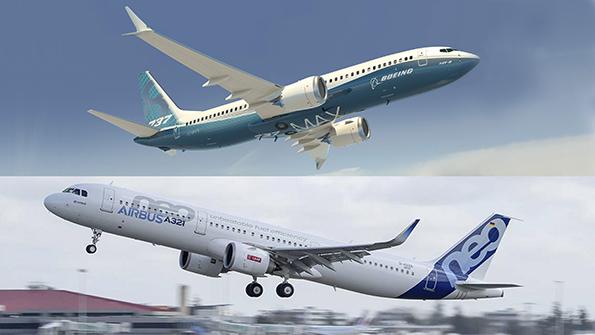
The Boeing-Airbus rivalry in commercial aerospace has become so engrained in popular culture that it would be easy to forget the duopoly truly started just two decades ago after Boeing bought McDonnell Douglas. Since then, the two companies have been fighting tooth and nail to launch new programs, win customer orders and ramp up their production rates, reaching their peak in 2018, when the two delivered 1,600 aircraft and generated $120 billion in revenues, with both the deliveries and revenues divided pretty evenly between them.
However, as the companies were celebrating their record deliveries, alarm bells started ringing. Two Boeing 737 MAX crashes within five months grounded the whole MAX fleet, and quality issues with the Boeing 787 also emerged. At the same time, Airbus announced it would stop producing its A380 jet, which cost more than $15 billion to develop, after selling just 250 units. Meanwhile, orders were drying up for its most recent widebody, the A350, with fewer than 100 new orders tallied in three years. Since then, of course, things have grown much worse, and both companies have been scrambling to mitigate COVID-19 crisis damage.
In the wake of such unprecedented shock, it is worth taking stock of where the Boeing-Airbus duopoly stands and what the future holds for both players.
At first glance, Boeing seems to be in a much worse situation than Airbus. As of November 2020, it had delivered only 118 aircraft for the year, while Airbus delivered 477, giving the European company an unprecedented 80% market share for yearly deliveries (see graph). Airbus’ orderbook is now almost 70% larger than Boeing’s. Additionally, Boeing has spent the last two years essentially firefighting, which means it has probably lost some ground in preparing for the next generation of airplanes. In the meantime, Airbus has been carrying on with the development of its A321XLR, which potentially pulls the rug from under Boeing’s work on addressing the “middle of the market” segment.
Nevertheless, one should not assess Airbus’ strengths simply based on Boeing’s current weaknesses. Airbus also has suffered from the crisis and in some respects still is structurally weaker than Boeing. First, its commercial aerospace business pretty much stands on its own (whereas Boeing can rely on a large and relatively stable defense and space business). Second, its industrial organization remains a multinational puzzle that is far from being optimized and still subject to political tensions between its home countries.
All things considered, though, Airbus has never been in a better position to take a significant lead over Boeing. Even if the balance of power lastingly tilts toward the European company, it should not fundamentally alter the duopoly dynamics in the medium term. The two players still will be dominant and compete head-to-head. Beyond the current decade, however, the big question is what the impact of China’s forthcoming entry will be.
Indeed, China’s first indigenously developed large commercial airplane—Comac’s narrowbody C919—is expected to come into service within a couple of years. This will mark the country’s official entry into the large commercial aircraft market and a major milestone of a long-term strategic play underpinning colossal geopolitical, industrial and commercial stakes. To succeed, it will need to rely on privileged access to a huge domestic market as well as an aggressive pricing strategy (the C919 could be priced 50% lower than the A320 or 737). But above all, selling commercial airplanes will become part of China’s “soft-power” strategy.
And while European or American airlines likely will not buy a Chinese airplane for some time, carriers in other regions may be enticed more easily. Of course, there are still many hurdles to be overcome for Comac to become a full-fledged competitor to Airbus and Boeing—not the least developing a robust supply chain and an international sales and service network. But in a world where trade wars could become increasingly the norm, China has a lot of assets to put forth.
Whereas the COVID-19 crisis has significantly dented Airbus’ and Boeing’s growth trajectories, it has boosted China’s quest to become an aerospace powerhouse. In the long term, China’s market entry is bound to alter the economics and the politics of the business, if only because it will force Boeing and Airbus to reconsider their global industrial strategy and take more risks on new product development.
Contrary to appearances, the Airbus-Boeing duopoly has never been a long, quiet river. It is certainly far from being one right now, and both players should brace for strong currents and treacherous rapids ahead.






Comments
Boeing operates like a hedge fund. The only thing which count are the share price and executive bonuses.
If Boeing does not return to its roots as an engineering driven aerospace company, its demise is only a question of time.
No one is going to buy a non certified aircraft let alone be allowed to operate one (and internal China will be forced to take even numbers)
The C929 project is falling apart and Russia is the one who has the certification path.
Which does them no good because they are pathetic on supporting the Super-jet that is certified.
Sure they can foist it off and Zimbabwe and there it is stuck.
The MC-21 has a lot going for it, but it will suffer the same fate as the Super Jet.
As for Boeing, its not a hedge fund, its a Pyramid scheme.
And the EU does not subsidize Arriane ? Or the rest of its space industry?
While US defense has serious issues with procurement, we get bang for the buck, its not just a jobs program.
No question the Space thing is a horrible bust, but then Space X is a huge win. We can shut down the NASA end and should. That is not on Boeing that is on NASA complete incompetence (they need to go back to X planes)